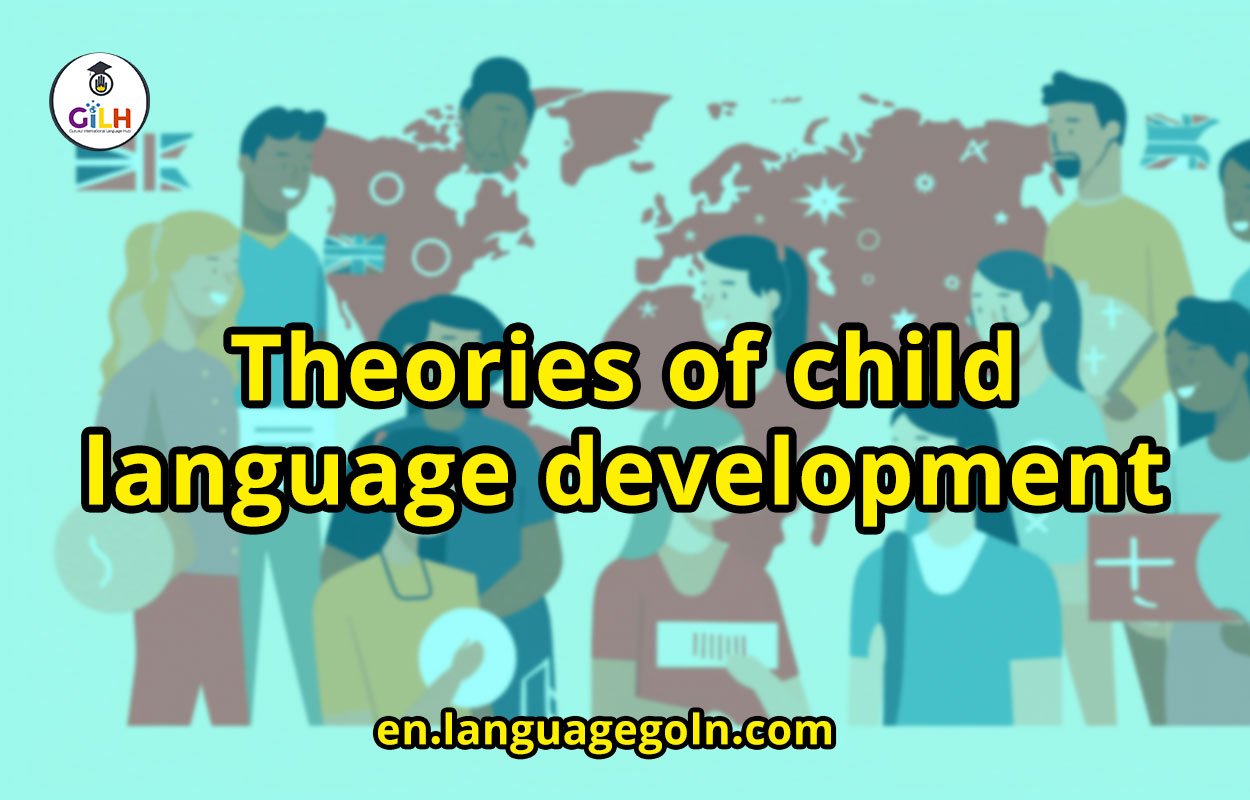Today our topic of discussion is – Theories of child language development
Theories of child language development
According to Wohlwill (2016), the prime source of data to establish theories of spontaneous language production is the children’s own language observed in a natural environment. Classical theories of child’s first language development are classified under the
following headings:
- empiricism/ behaviourism,
- cognitivism
- rationalism/ nativism
- inter-actionist/ constructivism and
- social constructivism.
Under the above mentioned themes foremost theories of child language acquisition have been put forward. They will be discussed in brief below.
Behaviourism
Behaviorism emerged in Linguistics at the beginning of the 20th century. Essentially, it is a psychological theory that has been developed to understand the essence of native language learning. B.F. Skinner was the most influential figure to take it ahead.
According to Skinner (1957), language is verbal behaviour and language learning is equivalent to the other skills that children learn in their lives. The behaviourist theory suggests that the importance of other human roles in infants’ oral language learning is very significant as it develops their language skill through imitation, rewards, and practice; therefore, human role models in infants’ environment also include stimuli and rewards (Cooter & Reutzel, 2004).
The key tenet of this theory relates to the analyses of human behaviour in terms of- stimulus-response- feedback-reinforcement and was developed, in particular, in Skinner’s ‘Operant Condition’ model (Rivers, 1981). By this term he meant the ‘conditioning of responses’ which includes self control and independence (factors that are fostered by reinforcement).
For example, if babies are rewarded for their varied babblings, and mutterings (similar to the words of a person around them), more similar types of combinations of syllables and words will be reinforced in the same circumstances. By the passing of time baby’s continuous development of sounds, clusters of sounds and utterances
are combined by analogy and generalization. Gradually, they are internalized as implicit spee ch and most of their sentences are similar to adults.
Behaviourists agree that an extremely complex language learning process could be completed by broken down into minute habits (Hubbard, 1983). In short, in this view language development is a matter of conditioning by means of practice, imitation, reinforcement and habituation, which reflect the speed of language acquisition.

In 1959 Abraham Noam Chomsky specifically criticized the notion that all learning. whether verbal (language) or nonverbal (general learning) takes place under the same underly ing mechanism. He said that there is no empiric evidence or any established reason to support the claim that all learning can take place only by habit formation (Chomsky, 1959). He placed the importance of environmental feedback and internal factors (like, the speaker) in learning.
This thought initiated by Chomsky and his followers developed another theory of language development known better as ‘Nativism’ or ‘Innateness’.
Nativism
Linguist Abraham Noam Chomsky presented a broad account of language development. He believed in some variation of “innateness hypothesis’ which considers that the child comes into the world already programmed in some ways to learn a language.
That means that children from birth inherit the ability to learn any human language and that helps children use certain linguistic structures precisely as they are already imprinted on the child’s mind. Chomsky explained that this may be a kind of ‘Language Acquisition Device’ (LAD) that would make it easier for the language users to generate new utterances that they have never heard or spoken before and this device would be programmed to recognize these universal rules that underlie a particular language (Chomsky, 1957).
Chomsky acknowledged the role of environment in learning a language; he says the language environment determines which of a number of languages as a child will learn (Gupta, 1995). For example, an English speaking child who did not grow up hearing ‘Bengali’ will not speak Bengali,
although the child is genetically capable of learning that language. But if he is exposed to Bengali, his LAD will help to acquire the language only by hearing it. Relevantly it is important to mention, one important thing about Chomsky’s theory is that, LAD cannot be modified by experience as it is hereditary programmed (Dovey, 2015).
Chomsky’s theory was accepted and elaborated by many other scholars like Mcneil (1968), Horstein& Lightfoot (1981), Bley- Vroman (1988) etc. Moreover, his theory was discussed in other fields (like, number, space, cause, object knowledge) also.
Even some of the researches on ‘cognitive development in infancy’ are also greatly influenced by the nativist theory. Chomsky wanted to establish that an innately specified linguistic processes constrained class of data in a specified linguistic way, Piaget contrasted on this thought. According to him, for linguistic and cognitive development on form of innately specified, domain specific knowledge is required (Piaget, 1936/1952).
He tried to explain how a child constructs a mental model of the world and sees cognitive development as a mechanism that occurs due to biological maturation and contact with the environment. This thought contributed to the establishment of the ‘Cognitive Development’ or ‘Cognitivism’ theory.
Cognitivism
Psychologist Jean Piaget positioned language acquisition in the context of the mental or cognitive development of a child. Piaget first proposed the most wide-ranging theory of ‘Human intellectual development’; thus he was considered by many
as the founder of the study of ‘Cognitive Development’. He has provided a theory to demonstrate how a child constructs a mental model of the world (Piaget, 1936/1952). According to him, language is just one component of the overall intelligence of a child and children acquire language with the help of cognitive skills. These abilities develop with biological maturation and environmental interactions.
According to Piaget, in order to psychologically construct the world, children first need to grasp a concept before they know the particular language that conveys the concept: for instance, there will be a point in the intellectual development of a child when he can equate objects with size.
This means the child could arrange some sticks given to him in order of size. This ability is called ‘categorization’ and it is a vital process in a child’s language acquisition period to get meaning through language use. Piaget indicated that children need to reach and achieve this stage to understand and use comparative adjectives like ‘bigger’ or ‘smaller’.
Another phenomenon related to cognitive theory is object permanence (Bremner et al, 2015). Children seem unaware of the existence of objects which they cannot see during the first year of life. By the time children reach the age of 18 months, they realize that existence of objects is independent of their perception.
Cognitive theory draws attention to the significant increase in children’s vocabulary at this age, indicating a link between object permanence and object label learning. The main idea of Piaget’s theory is based on the idea that, knowledge is constructed; this construction process is fundamentally same in all human cultures.
Piaget contributed majorly on how children are studied; as a result all his work is the founder of the study of ‘Cognitive Development’. He has provided a theory to demonstrate how a child constructs a mental model of the world (Piaget, 1936/1952). According to him, language is just one component of the overall intelligence of a child and children acquire language with the help of cognitive skills. These abilities develop with biological maturation and environmental interactions.
According to Piaget, in order to psychologically construct the world, children first need to grasp a concept before they know the particular language that conveys the concept; for instance, there will be a point in the intellectual development of a child when he can equate objects with size. This means the child could arrange some sticks given to him in order of size.
This ability is called “categorization” and it is a vital process in a child’s language acquisition period to get meaning through language use. Piaget indicated that children need to reach and achieve this stage to understand and use comparative adjectives like ‘bigger’ or ‘smaller.
Another phenomenon related to cognitive theory is object permanence (Bremner et al, 2015). Children seem unaware of the existence of objects which they cannot see during the first year of life. By the time children reach the age of 18 months, they realize that existence of objects is independent of their perception.
Cognitive theory draws attention to the significant increase in children’s vocabulary at this age, indicating a link between object permanence and object label learning.
The main idea of Piaget’s theory is based on the idea that, knowledge is constructed; this construction process is fundamentally same in all human cultures. Piaget contributed majorly on how children are studied; as a result all his work is constructed onthe basis of observing children. His “observations of infants’ understanding of
object” concept is valid till today. Moreover, developmental psychologists are very much influenced by his theory. According to Piaget, human beings are born with primitive mental processes and these processes are our basic action patterns called “sensory motor schemes’ (Pinget, 1936/1952). Later, on the basis of this action patterns more sophisticated mental structures are constructed.
Piaget gave four stages of language acquisition (which are at the core of his theory), which will be discussed later in the stages of language acquisition section,
Later, few significant theories of language development off-shoot of Piaget’s cognitive theory, giving priority on social factors on child cognitive growth.
The following theory is one of the theories that are influenced by Piaget’s cognitive theory.

Social constructivism
Psychologist Jerome Bruner was one of the founders of constructivist theory. He was influenced by Jean Piaget and gave a theory of child language development called-“social constructivist theory of cognitive development”.
He believed that social factors, especially languages are important for cognitive growth. He thinks, children could be facilitated by developing their symbolic thinking skills using language.
In particular, Bruner proposed three modes of language representation which are the way information or knowledge is processed and encoded in memory (Bruner, 1966). They are-
Enactive representation (0-1 year): It is an action based mode that encodes action- based information and stores it in our brain. For example, an infant might remember shaking rattling as a movement muscle memory.
Iconic representation (1-6 years): Here the information is stored visually in the form of (mental) images. Therefore, it is also helpful to have diagrams or illustrations to accompany the verbal information when we learn a new topic.
Symbolic representation (7 years onwards): This mode develops at the end and here
information is stored in the form of a code or symbol, such as language. Symbols are versatile in that they can be manipulated, organized, classified etc., so that the user is not limited by actions or images. Knowledge is stored primarily as words, mathematical symbols, or other symbol systems at this symbolic representation stage.
According to Bruner, Language Acquisition Device (LAD) should have Language Acquisition Support System (LASS) and by this he refers to the child’s family and social environment in which he acquires language. And the language used in adult and child interactions is called Child Directed Speech (CDS).
Finally, Bruner’s theory can be concluded by mentioning his idea of ‘scaffolding”, which involves helpful, the prearranged interaction between an adult and a child that aims for helping the child achieve a specific goal. Bruner emphasized that, adults’ interaction with children strongly support acquisition process.
Social learning theory.
Another influential theory that offshoot from behaviourism is known as ‘Social Learning Theory”. This version of thought was initially outlined by Albert Bandura and his colleagues in 1963, but later established and presented in detail by Bandura (Bandura, 1971).
Like Skinner Bandura and his colleagues emphasized on the role of environment in development, but they believed that, ‘behaviour is learned, not only by shaping and reinforcement, but also by watching and imitating others’ (Bandura, Ross & Ross, 1961). Social learning theorists were interested very much in socialization or as can
said to be the process by which children learn the appropriate behaviour of their society. Later in 1980’s, this theory was renamed as the ‘Social Cognitive Theory’ (Bandura, 1989).
This theory is important for its recognition of children’s cognitive development along with the normal imitation process. Accordingly, Children’s later actions are guided by the experiences they gain through observing other children and adults forming concepts about possible behaviours; children can even change their actions and concepts after observing their behavioural consequences (Gupta, 1995).
Behaviourists and nativists view the child as passive learners, where constructivists and social constructivists find children actively participating in language development. Again, to the behaviourists development is the result of learning on the basis of imitation/ modeling; whereas nativists say that development results in maturation (innate structure/ LAD).
Constructivists think of it to be structured through adaptation and organization; finally, development is seen as the result of changes both in internal structures and through instruction that occurs through reconstruction. Behaviourists put emphasis on the role of the environment and the past history of the child on the topic of nature and nurture,
whereas nativists emphasized the role of innate factors (such as maturation). Both the constructivists and social constructivists explained the nature of development from social perspectives and discussed the influence of cultural context.
Each theory focuses on various developmental factors and makes different assumptions about the relative importance of both internal and external influences. Each theory has contributed greatly to our knowledge about human nature and development” (Gupta, 1995).
Usage based theory of language acquisition
The ‘Usage Based Theory’ of language acquisition by Michael Tomasello (2003) drew much attention for his novel theoretical perspective in the field of first language acquisition in children. It took most of its insights from cognitive theory.
American linguist Michael Tomasello developed this theory. According to Tomasello and other followers of this theory, pragmatics of human communication are primary as both meaning and structure emerges from language use within cultural conventions (Tomasello, 2000). Thus his theory is regarded as the “Social Pragmatic Approach’ to language acquisition.
Tomasello claimed that two sets of skills emerge in human child before linguistic communication; they are- (a) intentional reading or functional dimension and (b) pattern finding or grammatical dimension. According to him, these two sets evolve to each other and children acquire language around at the age of one with the help of these two dimensions.
Intention reading is actually a social cognitive skill that enables children to symbolize acquisition culturally by detecting adults’ social conventions to meet social ends. It includes ‘joint attention’ which is central to cognitive construction.
Secondly, pattern finding helps children create abstract linguistic schemas or constructions that go beyond the individual utterances they hear people use around them. Pattern finding is regarded as the central issue in the usage based theory of grammar acquisition (Goldberg, 2003 & Tomasello, 2003).
Usage based theory claims that infants start communicating in some comparatively sophisticated ways before they acquire any linguistic conventions(like pointing or any kind of iconic or conventionalized gestures); therefore,
in order to understand the nature of child languages and how they are acquired, one must always begin by analyzing their communication process broadly. This theory emphasizes on the importance of joint attention frame (adult’s and child) as a medium of early communication within a mutually understood context. Like, if a child is engaged with an adult in cleaning the toys,
pointing by the adult towards a toy in a corner makes the child understand that she has to bring it and clean it up too; mutually shared topic helps a child acquire meaning in a given context (Grassman & Tomasello, 2007). In this way children become capable of comprehending their role as well as the role of their communicative partner’s and it is very important in meaning acquisition (Carpenter et al., 1998).
Why do children communicate or what are their communicative motives are also stretched in this usage based approach. Bates et al.(1989) discussed only of two types of motives- ‘declarative’ and ‘imperative’; but Lizskowski indicated another kind of motive- ‘the informative motive’.
But whatever the type of motives might underlie children’s pre- linguistic communication; all of them serve the same purpose which is building infants’ early language structures upcoming in the next few months (Lizskowski et al. 2006).
Another important issue is discussed elaborately in the usage-based theory is ‘how children learn words’. According to Tomasello, infants start communicating with the basic unit of linguistic expressions, which are utterances.
Along with some speech act these utterances later on composites structures. When an adult talks to child he or she tries to complete two stages at the same time- firstly, they look for communicative intention and then for communicative functions of the utterances; and repeated utterances with the same phonological elements are counted as words by the child. Moreover, if
the key word is stressed by the adult, then this process boosts up and child’s vocabulary develops. Finally, by looking at the commonalities of functional role in utterances, children indirectly learn words.
Children start joining two relevant words or ‘holophrases’ to express meaning around at the age of 18 months (Tomasello, 2003). This communication-based, usage-based way of looking at things shows that it is not possible to describe the ‘grammatical competence learning’ of children by beginning with individual words acquired in isolation and then gluing them with abstract meaningless rules.
We need to start with the comprehension and production and of whole meaningful utterances of the children. Thus, Tomasello’s usage based theory of language acquisition can be taken seriously for suggesting that the language structure emerges from their language use and this is applicable at the individual word level,
as their communicative function stems out from their language use as well as from their grammatical competence. In addition, structure emerges from multi- unit utterances use patterns and this is achieved through general cognitive processes.
Even from the same viewpoint universal linguistic structure derives that people everywhere have the same set of general cognitive process. Usage based theory of language acquisition thus undoubtedly presents new thoughts for researchers involved in this field.
See more

